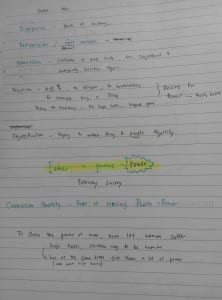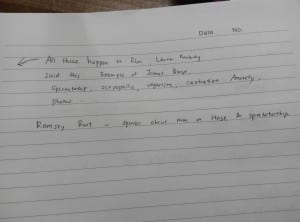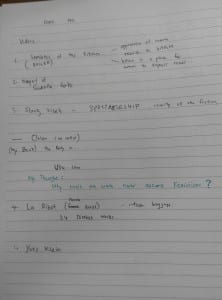SPECTATORSHIP
The Society of the Spectacle
What Jerome Bel said about the book of The Society of the Spectacle in his performance : ‘We don’t live a life anymore, it has been replaced by its representation.’
For me, by watching the video itself is a representation. How the filmmaker represent what he has recorded and what he wants people to watch is representation.
It makes me think of what I have learned from reading The Way of Seeing by John Berger. Such as the video, news, films are actually framed and controlled by the person who shoot and edited it. We are watching the way that person’s gaze.
In the video, it mentioned that power is the root of spectacle. Spectacle(refer to mass media) is a social relationship between people that is mediated by images. With the appearance of spectacular society, it ruin the quality of human life because of lack of authenticity and this also affected human’s perceptions.
One thing I thought of is human beings are so easily affected by images. Image always help to understand something more easily. Image comes before word.
There is a statement created by Karl Marx,’within the capitalist mode of production we evaluate materials not by what purpose they serve or what they’re actually useful for, but we instead recognize them based on their value in the market.’ Therefore in the society of the spectacle, there is a point saying that the commodities(material/product/thing) rule the workers and the consumers instead of being ruled by them. Commodity as the power that was colonising all social life. The consumers are passive subjects that contemplate the reified具体化 spectacle. In society of consumer, spectacle uses images to make-believe people think of the things they need and must have.
Tourism – is the opportunity to go and see what has been banalised.
Visual Pleasure and Narrative Cinema by Laura Mulvey
In the introduction of the article, writer used psychoanalysis to review the fascination迷恋/魅力 in the film is strengthen by the fascination that already happened individually and society which shaped him.
[Political weapon] Film reveals the society which interprets sexual difference and this control the images, erotic ways of looking and spectacle. By using psychoanalysis theory to shows the patriarchal society that has structured film form. Woman function in forming patriarchal is when she first symbolises the castration threat by her real absence of a penis, and thereby raises her child into the symbolic. Woman stands in patriarchal culture as signifier for the male, bound by a symbolic order in which makes the man have fantasy and obsession through linguistic command.
Destruction Pleasure as Radical Weapon
Erotic pleasure in film.
Hollywood style has the skilled and satisfying manipulation of visual pleasure, coded erotic into the language of dominant patriarchal order.
Pleasures that offer from cinema:
– scopophilia, looking & being looked at taking other people as objects, subjecting them to a controlling and curious gaze. Erotic basis for pleasure in looking at another person as object, it can produce obsessive voyeurism. Playing on audience voyeuristic fantasy and sense of separation, sexual stimulation.
– Darkness, light & shade promote illusion of voyeuristic separation, give spectator an illusion of looking in private world.
– Develop scopophilia in its narcissistic aspect, where mainstream film put attention on human form (human face, human body, relationship of human form & its surrounding).
– Jacques Lacan describe mirror:
Recognition of joyous of imagines the mirror image to be more complete & perfect than own body experience. Recognition (reflected body as self) overlaid with misrecognition (outside body itself as an ideal ego, alienated subject).
Woman as Image, Man as Bearer来人 of the Look
– sexual imbalance, active/male and passive/female. Traditionally, women appearance with strong visual and erotic impact being displayed and looked at by male gaze.
The Ballerina Phallic by Susan Leigh Foster
The text explained and analysed how a ballet duet of female and male dancers, which show the very distinctive gender behaviour – masculine and feminine qualities. She always be the object that putted in front and adored by him.
Ballet spread all over the world through colonial, media and performances. It’s aesthetic has transformed form time to time. Yet, it shows the very clear image and ideal of balletic bodies to the world.
Both her and his bodies bear the marks of colonisation and colonial contact.
An interesting point saying that the dancers erase the painfulness, struggle of their body from their facial expression. Only showing lightness, effortless of appearance even though they are doing some extreme movements.
However ballerina always become the focus point while dancing a duet with a male dancer, she achieves no tangible and enduring identity. Just as he conveys her, and she conveys desire. She exist as demonstration of the desire which is not real. He manipulated her (phallus) with his forces. To say this, it related with the gendered bodies developed historically in ballet tradition. In ballet performance, she, either she look through his eyes in order to actively assert attraction / empathise passively as the object he desired. This is all because of male hegemony, masculine logic which makes woman to be the perfect object for male gaze. The ballerina-as-phallus has problematizes the male viewer’s gaze: his identification on stage is an unmanly man (a man in tights), where he must pass on his way to become the object of fascination. In most of the dance performances, gendered identities often being considerate.
Index:
Spectacle – a visually striking performance or display.
– presents itself simultaneously as all of society, as part of society, and as instrument of unification. As a part of society it is specifically the sector which concentrates all gazing and all consciousness. Due to the very fact that this sector is separate, it is the common ground of the deceived gaze and of false consciousness, and the unification it achieves is nothing but an official language of generalized separation.
Narcissism – formation of the ego and the ideal ego,
the role of narcissism in love, sexual relationships, and self-concept.
Detournement – a term coined by Guy Debord and the Situationist International (SI) movement of the 1960’s, Detournement is usually translated into English as ‘diversion’ and was the method of artistic creation used by the situationists.
Commodity Fetishism – is the perception of the social relationships involved in production, as economic relationships among the money and commodities exchanged in market trade. As commodity fetishism transforms the subjective, abstract aspects of economic value into objective, real things that people believe have intrinsic value
Castration Anxiety -(psychoanalysis) anxiety resulting from real or imagined threats to your sexual functions. An overwhelming fear of damage to, or loss of, the penis. Example like eunuchs? The counterpart of castration anxiety for females is penis envy.
Slavoj Žižek – a Slovenian Marxist philosopher, psychoanalyst and cultural critic, a senior researcher. He writes widely on a diverse range of topics, including political theory, film theory, cultural studies, theology, and psychoanalysis.
Karl Marx – was a German philosopher, economist, sociologist, historian, journalist, and revolutionary socialist. Marx’s work in economics laid the basis for the current understanding of labour and its relation to capital, and has influenced much of subsequent economic thought. He published numerous books during his lifetime, the most notable being The Communist Manifesto and Das Kapital.



